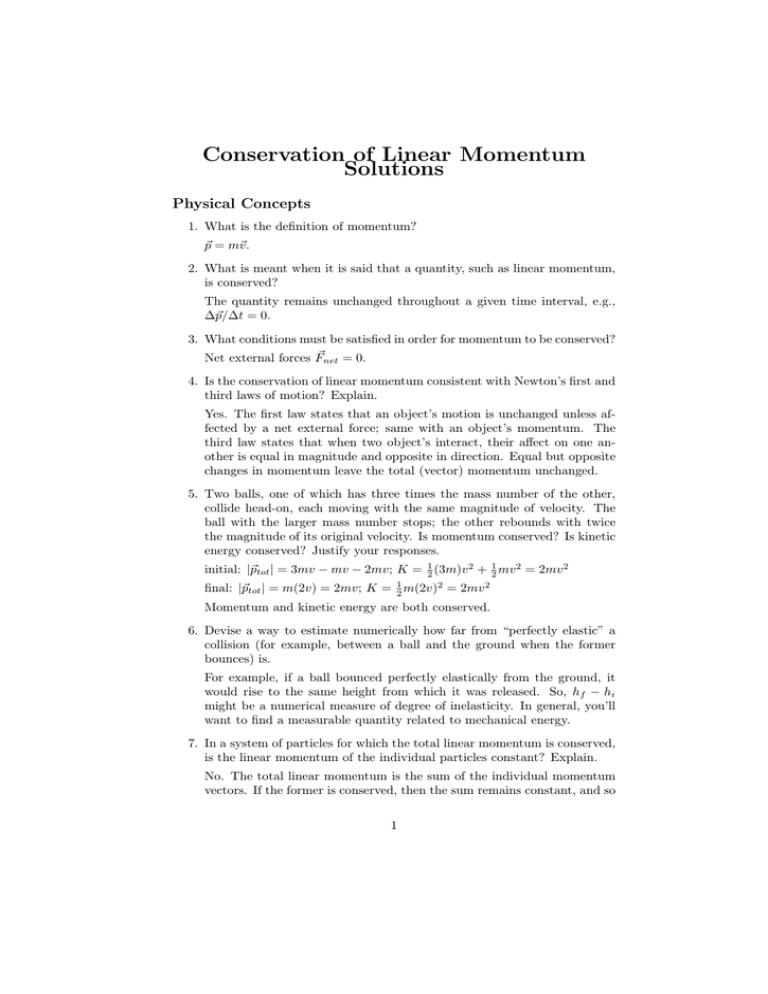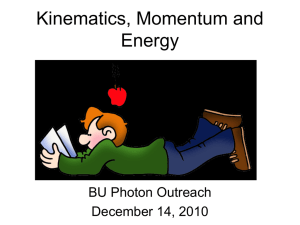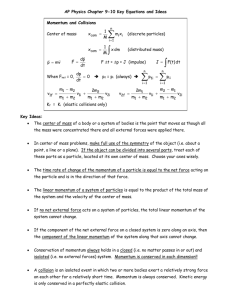Conservation of Linear Momentum Solutions
advertisement

Conservation of Linear Momentum Solutions Physical Concepts 1. What is the definition of momentum? p~ = m~v . 2. What is meant when it is said that a quantity, such as linear momentum, is conserved? The quantity remains unchanged throughout a given time interval, e.g., ∆~ p/∆t = 0. 3. What conditions must be satisfied in order for momentum to be conserved? Net external forces F~net = 0. 4. Is the conservation of linear momentum consistent with Newton’s first and third laws of motion? Explain. Yes. The first law states that an object’s motion is unchanged unless affected by a net external force; same with an object’s momentum. The third law states that when two object’s interact, their affect on one another is equal in magnitude and opposite in direction. Equal but opposite changes in momentum leave the total (vector) momentum unchanged. 5. Two balls, one of which has three times the mass number of the other, collide head-on, each moving with the same magnitude of velocity. The ball with the larger mass number stops; the other rebounds with twice the magnitude of its original velocity. Is momentum conserved? Is kinetic energy conserved? Justify your responses. initial: |~ ptot | = 3mv − mv − 2mv; K = 12 (3m)v 2 + 12 mv 2 = 2mv 2 final: |~ ptot | = m(2v) = 2mv; K = 21 m(2v)2 = 2mv 2 Momentum and kinetic energy are both conserved. 6. Devise a way to estimate numerically how far from “perfectly elastic” a collision (for example, between a ball and the ground when the former bounces) is. For example, if a ball bounced perfectly elastically from the ground, it would rise to the same height from which it was released. So, hf − hi might be a numerical measure of degree of inelasticity. In general, you’ll want to find a measurable quantity related to mechanical energy. 7. In a system of particles for which the total linear momentum is conserved, is the linear momentum of the individual particles constant? Explain. No. The total linear momentum is the sum of the individual momentum vectors. If the former is conserved, then the sum remains constant, and so 1 the individual momenta may vary, as long as there is mutual compensation (as in Newton’s third law). 8. A firecracker is at rest on a frictionless horizontal table. The firecracker explodes into two pieces of unequal mass that move in opposite directions on the table. (a) Is the net force on the left piece always zero? Explain. No. The motion of the left piece changes, so it must experience a force. (b) Is the net force on the system consisting of both pieces always zero? Explain. Yes. There is no external influence, so the net force on the system must remain zero. (c) Is the momentum of the left piece conserved? Explain. No. It starts from rest and then moves. (d) Is the momentum of the system consisting of both pieces conserved? Explain. Yes. Their momenta are equal in magnitude and oppositely directed, thus summing as vectors to zero. 2






